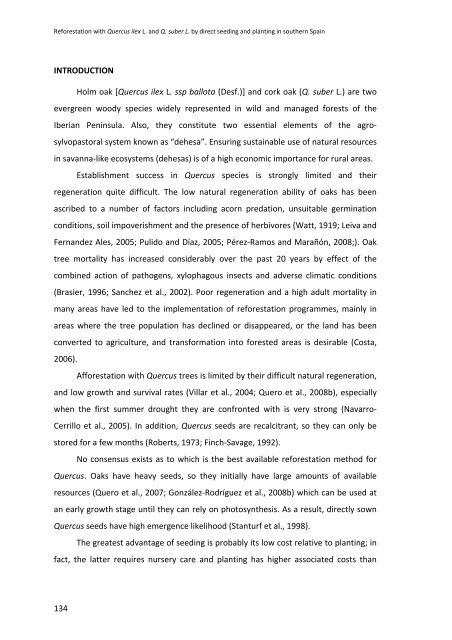Establecimiento de cuatro especies de Quercus en el sur de la ...
Establecimiento de cuatro especies de Quercus en el sur de la ...
Establecimiento de cuatro especies de Quercus en el sur de la ...
You also want an ePaper? Increase the reach of your titles
YUMPU automatically turns print PDFs into web optimized ePapers that Google loves.
Reforestation with <strong>Quercus</strong> ilex L. and Q. suber L. by direct seeding and p<strong>la</strong>nting in southern Spain<br />
INTRODUCTION<br />
Holm oak [<strong>Quercus</strong> ilex L. ssp ballota (Desf.)] and cork oak (Q. suber L.) are two<br />
evergre<strong>en</strong> woody species wi<strong>de</strong>ly repres<strong>en</strong>ted in wild and managed forests of the<br />
Iberian P<strong>en</strong>insu<strong>la</strong>. Also, they constitute two ess<strong>en</strong>tial <strong>el</strong>em<strong>en</strong>ts of the agrosylvopastoral<br />
system known as “<strong>de</strong>hesa”. En<strong>sur</strong>ing sustainable use of natural resources<br />
in savanna‐like ecosystems (<strong>de</strong>hesas) is of a high economic importance for rural areas.<br />
Establishm<strong>en</strong>t success in <strong>Quercus</strong> species is strongly limited and their<br />
reg<strong>en</strong>eration quite difficult. The low natural reg<strong>en</strong>eration ability of oaks has be<strong>en</strong><br />
ascribed to a number of factors including acorn predation, unsuitable germination<br />
conditions, soil impoverishm<strong>en</strong>t and the pres<strong>en</strong>ce of herbivores (Watt, 1919; Leiva and<br />
Fernan<strong>de</strong>z Ales, 2005; Pulido and Díaz, 2005; Pérez‐Ramos and Marañón, 2008;). Oak<br />
tree mortality has increased consi<strong>de</strong>rably over the past 20 years by effect of the<br />
combined action of pathog<strong>en</strong>s, xylophagous insects and adverse climatic conditions<br />
(Brasier, 1996; Sanchez et al., 2002). Poor reg<strong>en</strong>eration and a high adult mortality in<br />
many areas have led to the implem<strong>en</strong>tation of reforestation programmes, mainly in<br />
areas where the tree popu<strong>la</strong>tion has <strong>de</strong>clined or disappeared, or the <strong>la</strong>nd has be<strong>en</strong><br />
converted to agriculture, and transformation into forested areas is <strong>de</strong>sirable (Costa,<br />
2006).<br />
Afforestation with <strong>Quercus</strong> trees is limited by their difficult natural reg<strong>en</strong>eration,<br />
and low growth and <strong>sur</strong>vival rates (Vil<strong>la</strong>r et al., 2004; Quero et al., 2008b), especially<br />
wh<strong>en</strong> the first summer drought they are confronted with is very strong (Navarro‐<br />
Cerrillo et al., 2005). In addition, <strong>Quercus</strong> seeds are recalcitrant, so they can only be<br />
stored for a few months (Roberts, 1973; Finch‐Savage, 1992).<br />
No cons<strong>en</strong>sus exists as to which is the best avai<strong>la</strong>ble reforestation method for<br />
<strong>Quercus</strong>. Oaks have heavy seeds, so they initially have <strong>la</strong>rge amounts of avai<strong>la</strong>ble<br />
resources (Quero et al., 2007; González‐Rodríguez et al., 2008b) which can be used at<br />
an early growth stage until they can r<strong>el</strong>y on photosynthesis. As a result, directly sown<br />
<strong>Quercus</strong> seeds have high emerg<strong>en</strong>ce lik<strong>el</strong>ihood (Stanturf et al., 1998).<br />
The greatest advantage of seeding is probably its low cost r<strong>el</strong>ative to p<strong>la</strong>nting; in<br />
fact, the <strong>la</strong>tter requires nursery care and p<strong>la</strong>nting has higher associated costs than<br />
134

















